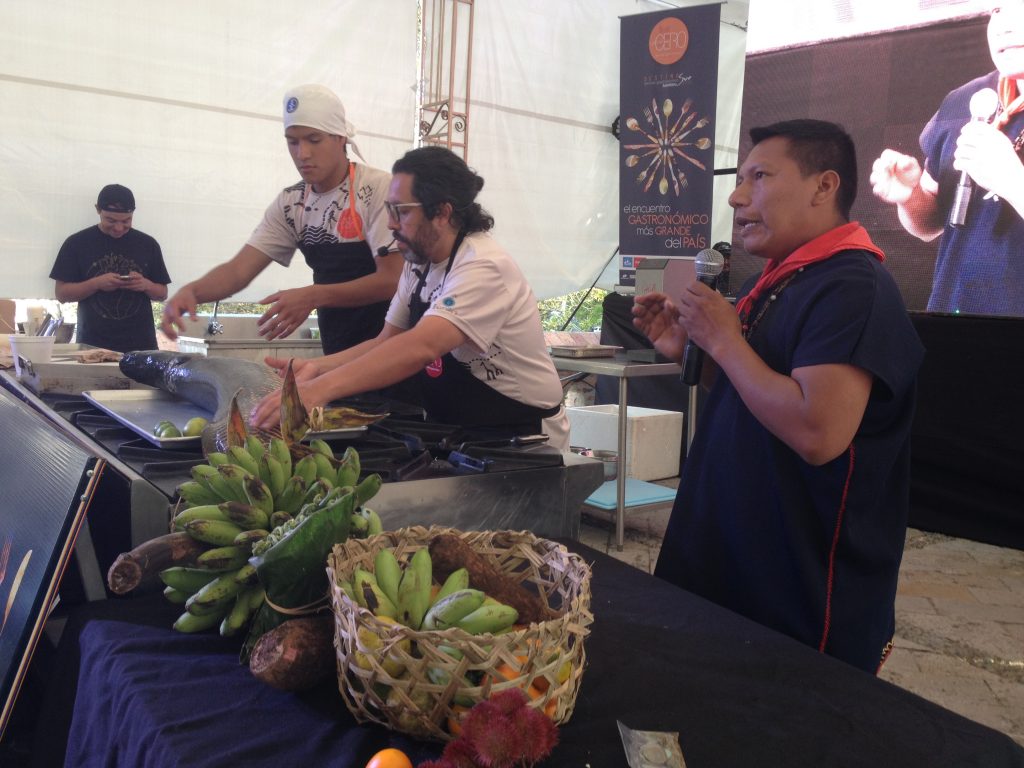Iván Ulchur-Rota
Roberto Aguinda, a Cofán indian, knew the paiche well when he fished it years ago in the jungle lagoons near his community in the province of Sucumbios, Ecuador. Paiche´s (Arapaima gigas) enormous size (up to 2-½ meters in length) and grumpy face has earned it the title of “river monster.” Last Thursday, during the event “Degusta Diversidad” – organized in Quito, Ecuador, as an initiative to promote ecological agriculture in the Amazon – I asked Roberto about this nickname. He laughed. For him, paiche is the opposite of a monster: the largest fish of the Amazon is increasingly sought-out by national and international chefs and creating new opportunities for his rainforest people.
“In terms of conservation, our work with paiche is considerably reducing the hunting that took place before,” explained Roberto during his presentation for the event organized by Espai-Epicur, Canopy Bridge, the UN GEF Small Grants Programme, and the Ministry of Agriculture. Sitting beside him were Kamilla Seidler, chef of the Bolivian restaurant Gustu –recognized as the best female chef in Latin America– and Mauricio Acuña, chef of the restaurant Patria, who’s at the center of a movement for local sourcing and innovative products in Ecuador.
Although native fish have since ancient times been critical for the diets and cultures of many indigenous communities in the Amazon, a boom in commercial fishing has seriously affected many species, including paiche. This is one of the reasons why Roberto stopped fishing to begin raising paiche in pools. “In the pools, they grow almost a kilo per month”, he tells me. “They grow with ease.” As a native species, its commercialization is not only being recognized as an sustainable alternative for communities involved in preservation. Now it´s seen as a delicacy by chefs like Acuña. During the festival “Latitud Cero”, the largest in the country, in the southern city of Cuenca, Acuña prepared ceviche with paiche for his keynote presentation. Months later, its potential was evident during “Degusta Diversidad”: paiche –the monster– was a star.
The Cofán people know a few things about monsters. When they organized in 2009 to press charges against the giant corporation Texaco for the pollution generated by their activity in their territory from 1964 to 1990, the world began to pay attention to their historical struggle to protect their way of life. It was a confrontation against an enormous entity that had contaminated their waters, devoured hectares of jungle, and had fractured the communities that inhabited it.
The impact these extractivist activities had on these communities was enormous. Their health, social structure and surroundings were seriously affected by the construction of roads in forests where they used to hunt and collect medicinal herbs. All that pressure on the jungle endangered previously abundant animals, making it difficult for the Cofan people to hunt and fish. As their territories shrank, they were forced to leave.
From an ancestral territory spanning millions of hectares across the border of Ecuador and Colombia, by mid-1980s the Cofan were reduced to isolated villages. Over the last two decades the Cofan have slowly regained territory and are now recognized as guardians of over 400,000 hectares of ancestral lands, spanning some of the most biologically diverse forests on earth – from the cloud-shrouded Andes to the jungle lowlands of the paiche.
Fish farming is part of that process of resilience, revitalization and preservation. With the support of The Nature Conservancy and Conservation International, Roberto and collaborators like William Lucitante have participated in many indigenous exchanges around fish farming. “The Ecuadorian Amazon does not have big ponds or lakes, so we’ve learned from Peruvian communities how to farm fish in small ponds or pools”. The work has expanded to other communities in different parts of the Amazon, where according to Roberto they also depended more on hunting and fishing than on farming. Now, things are different.
The creature which some describe as a monster has gone through a complete makeover, changing the gastronomical reputation of the Amazon in the process. While a year ago the Amazon was virtually invisible in restaurants in Quito, paiche – as well as cachama (think of it as a vegetarian piranha) – now gets love from some of the most innovative chefs in the city. Now, six restaurants serve paiche consistently. Seven more are interested in putting paiche in their menu. This is excellent news for conservation of the Amazon and for the communities that protect it. “With this we get enough to pay for what we need”, says Roberto about his market philosophy. It is not about profit or accumulation – but about utilizing commerce as a preservation strategy, increasing the value of the resources they control. With the help of Conservation International and The Nature Conservancy, the communities involved in these fish-farming initiatives continue their outreach work in Quito and other Ecuadorian cities. Their presence in Latitud Cero, the largest gastronomy festival in Ecuador, evidenced those efforts.
The Cofan territory spans to about 400 thousand hectares. Except for two communities, most the territory is a protected areas. Communities are organized with their own park “rangers” and constant training. “We learn a lot from other nationalities”, reiterates Roberto, visibly proud of a project in line with their status as “guardians of the forest”.



One thought on “Fish-farming paiche: a Cofan alternative to preserve the forest”